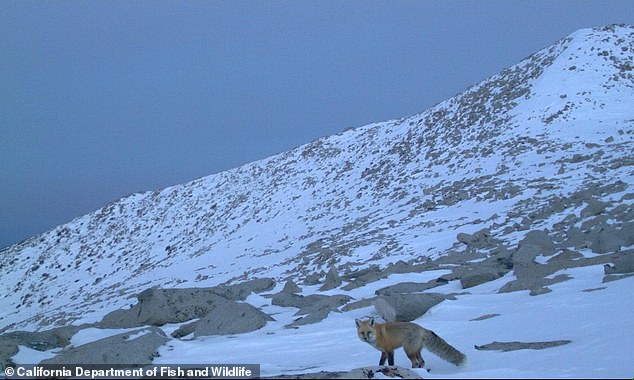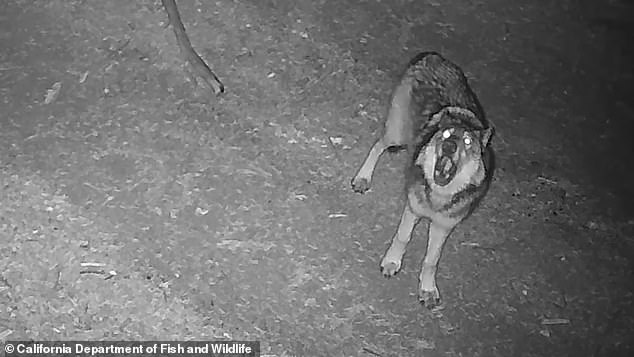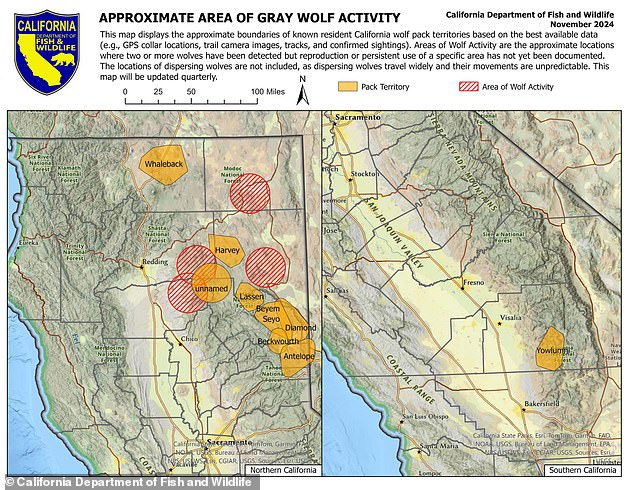Major warning for hikers as apex predator thought to be extinct for a century is spotted in California park
For the first time in a century, a pack of gray wolves was spotted in a U.S. National Park, officials said.
The species was thought to have been chased out of Lassen Volcanic National Park in the 1920s, but was spotted again last month in the form of a small pack.
The group, consisting of a mother, a father and their two pups, was detected by a camera trap just south of the vast expanse of Northern California, the U.S. Forest Service said.
The family could use “portions of the park” as their habitat, the department’s “gray wolf coordinator” said said in a statement – while others marveled at their return.
‘Yes!! We needed this glimmer of hope,” one Facebook user responded when California Wolf Watch officials shared information about the sighting last Sunday.
‘So excited. I hope this platoon survives,” said another, as similar celebrations were seen over the course of several comments.
All commented on what appears to be the beginning of a slow return to the mountainous region by the canines, considered an apex predator.
Such a development would drastically change the ecosystem, agency officials reiterated in their statement, while confirming earlier reports from the same pack.
Scroll down for video:
For the first time in a century, a pack of gray wolves was spotted in a U.S. National Park, officials said. A still shows a wolf from another pack in Northern California

The species was thought to have been chased out of Lassen Volcanic National Park in the 1920s, but was spotted again in pack form last month. The Sierra Nevada Red Fox, which roamed Lassen Volcanic National Park in February, could benefit
“I also wanted to clarify that the conversations I have had with the state wolf coordinator… that detections have occurred in the park,” the group wrote in response to the Active NorCal report being reshared.
“We have been made aware of sightings in the park of this pack,” the message continued.
“This news was not reported by us first.”
After speaking with state wolf coordinator Axel Hunnicutt, the group said, it became clear that the sighting of the recovering endangered species was above board.
“They are currently unnamed and this yet-to-be-named wolf pack is one of dozens of groups/packs confirmed to be living in California,” the group added in its bulletin.
‘It is unknown which pack the breeding adults currently come from.’
As it stands, there are currently eight packs of gray wolves roaming California – now nine, with this new pack.
Like the grizzly, the species was wiped out of the state by game hunters in the 19th and 20th centuries, causing packs to fan out and repopulate.

A wolf from the pack found earlier this year in the Sequoia National Forest is seen here howling

The more recent sighting is significant because it marks a return to the region since wolves began recolonizing California in the 2010s, officials said.
They left California and settled in several states such as Montana, Idaho, Oregon, and the Yellowstone area of Wyoming.
However, in the 2010s it became clear that a gray wolf recolonization effort was underway.
Sightings across the Golden State showed the animal slowly returning to the state’s outskirts, with officials naming and identifying eight different packs.
“This finding is also important because it marks the ninth current pack in California, and the tenth in modern times since wolves began recolonizing CA in the 2010s,” Hunnicutt explains.
“As this group was found to have pups, we will work to monitor their survival into the new year as this will help quantify the recovery of the state’s wolf population,” he added in an e-mail this week email.
He added that the sighting is the closest to the park yet and could have greater connotations for local wildlife.
In the absence of the gray wolf, coyotes have taken their place in the eat-or-be-eaten heap, leaving the Sierra Nevada’s similarly endangered Red Fox population to suffer.
“Sierra Nevada red foxes have been negatively impacted and are being outcompeted by coyotes,” California Wolf Watch member John Marchwick said this week.

The gray wolf is a recovering endangered species protected by California and federal law, with nine known packs, including this one active in the state
“So with the return of wolves to California, it is expected that wolves will reduce the number of coyotes, leading to a potential increase in the number of red foxes in the Sierra Nevada.
“Something similar was observed in Yellowstone after wolves were reintroduced to the park in 1995-1996, with an increase in red fox numbers occurring after wolves were reintroduced,” he added.
Hunnicutt, meanwhile, clarified that the recent sighting occurred near the park’s southern border because the animal is now federally protected.
The California Department of Fish and Wildlife has not yet released more information.
